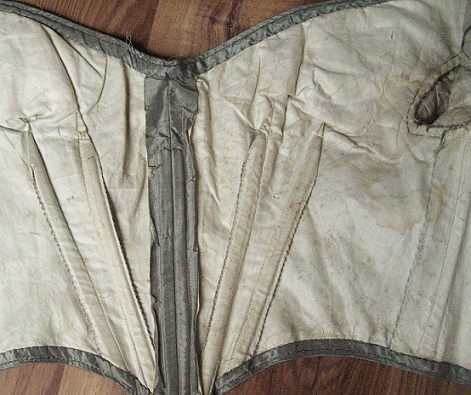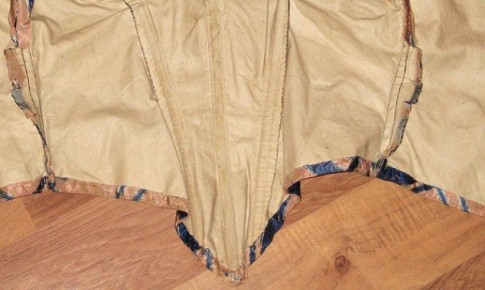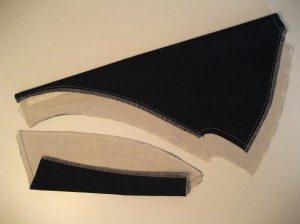
No, I’m not actually talking about dying or death (although so much of it happened in the early years of this decade because of the American Civil War).
I’m also not discussing how a costume project nearly “kills you” in its journey to completion. (ha!)
Flatlining in the dressmaking or costuming sense is the technique of mounting your fashion fabric onto a sturdy underlining fabric then treating the piece as one. As you go through the construction you handle the piece as if it was only one layer.
Let’s look at how this works in bodices of the 1860s.
Flatlining your fashion fabric gets your garment off to the best start with a sturdy base for trims and obtaining a close fit. It is essential in your historical clothing (as well as period accurate) and should not be overlooked.
Long ago, when I first started sewing 19th Century clothing, I was told to use a sturdy fabric for my flat lining. Back then (as now), coutil was the sturdiest thing around. So I opted to spend the money to use coutil on the inside of my bodices. Well….
I’ve learned since then that, except in extreme cases (e.g. really flimsy fashion fabric or when applying heavy trim), a tightly woven cotton fabric, such as stiff muslin or twill, will do the job well. Most of the time you don’t need to make your bodice stand up on its own. Coutil will do this and is probably not the best choice for your project.
Let’s look at an existing period example.

You can see in this antique bodice the underlining is a simple, tightly woven cotton. A modern cotton poplin would work beautifully for a reproduction. Also, current polished cottons are also a wonderful period-appropriate fabric to use for bodice underlinings.
Keep your underlining fabrics light colored, e.g. white, off-white, ecru, tea-dyed, etc. If you’re sewing with black or dark fabrics where the underlining may show, you can use darker colors.
(Or if you’re like me, debate over & over on that piece in your stash, use it, decide it’s wrong, then make a note for next time to use a different color….)
Many surviving examples of Civil War era bodices (in everything from a sheer to heavy mourning taffeta fashion fabric) have a white or tan underlining.
Flatlining 1860s Style, circa 2012:
Flatlining your mid-century bodices can be done with basting by hand or machine or with various glue products such as Fabri-Tac, Stitch Witchery, and Sulky KK2000 spray adhesive.
My friend Bridget swears by a temporary spray adhesive where you can reposition your underlining to your fashion fabric. Although for me, I’ve never got the hang of it which frustrates me and takes so much more time. The fabrics also “un-stick” from each other too quickly for me to sew.
1860s bodices are most often a front, center back (with or without a seam) and side back pieces. You’ll want to use these same pattern pieces to cut both the fashion fabric and the underlining.
- Place the wrong sides of both fabrics together. This way the correct side of your underlining will show on the inside.
- Baste around the long vertical sides. Depending on the fabrics, I’ll leave the smaller edges (top, bottom, armhole, neck) open. These areas usually stay put during the rest of the construction. Many times I’ll run the seam edges through my serger so they’re already finished. No need to serge necklines or hems.

- Start at each raw edge and sew completely to the other edge. Break your thread after each side – don’t sew around the pattern piece in one stitch.
- For darts, hand baste down the center of them (both layers together). The bodice lays better if your darts are sewn with both layers (plus it’s how “they” did it).
- I like to give all my flatlined pieces a quick run through with my iron to set everything nicely.
- After sewing the seams the basting stitches can be clipped at intervals or removed altogether so the fabrics lay flat on the inside.
- You can leave the underlining fabric as the visible inside surface of your bodice or you can sew together a regular lining from your bodice pattern and whip it to the inside to cover all the seams. Although I haven’t come across a separate bodice lining as the norm for 1860s bodices. But they were done. Besides if your seams were easily accessible you could easily alter the garment.
However you flatline your Civil War era bodices, either with spray, hand or machine basting, you’ll want to at least make sure to add an appropriate underlining to the fashion fabric. It’s so vital to a well-supported garment. Plus it makes it period accurate in both appearance and fit.
What are your favorite flatlining strategies? Any particular method you use to attach your underlining to your fashion fabric? Share your ideas in the comment box below.

So glad to have found this site. Just starting sewing 1860’s clothing and this is a wealth of information.
Welcome to our Joyful Community Kathy! 🙂
My wedding corset was flatlined, but I haven’t used it for much else…I will definitely be adding this technique to my projects! Thanks
I also sandwich a layer of silk organza in between the fashion and the lining. This gives it a crisp look and body without the bulk. Love your blog!
I flatline anything that would benefit from it, and as you know, that’s nearly everything. I use different techniques depending on the fabrics, but I find that I generally use a washable glue stick on smaller pieces, and run a thin bead of Elmer’s washable school glue right out of the bottle in the seam allowances of large pieces. It takes a bit of practice to get just the right amount (and it’s important to stay in the seam allowances), but it’s quick, incredibly cheap and works well. Inner construction elements (darts, tucks, etc.) are always done with hand basting. Hand-tailored pieces that I’ll be spending a lot of time with (coats, jackets, waistcoats) are always done by hand as I don’t trust the glues to be terribly long-lasting.
Personally, I’d steer clear of using twill to underline. Use any tabby weave you like, but twills have a tendency to grow. I’d worry that the support one seeks in the underlining would be undermined by the lack of stability in a twill.
I have a question about flat lining construction. I have fallen in LOVE with this technique, I just started using it and I would like to know what are some ways to finish off the necklines and hems.
Simply finish the neck & hem with bias tape. I don’t even baste my fashion fabric & underlining together at those edges when flatlining. Sometimes I will though before I finish them.
Flatlining rocks! So glad you are using this historical technique. 🙂
I see now. My silly self have been making facings to finish my necklaces. I have been having to deal with bulk issues. Thank you so much.
Is the neck & hem then covered with trim? I made a victorian jacket for my daughter and flatlined it with twill. I then used a heavy weight iron in fabric pellon ,Made it so still it could stand by itself.!,Looked terrible!-wore it anyways cause I literally ran out of time Just spent last night peeling it out of the jacket(costume satin from Joann’s) gah! made funny “morie satin” designs on the satin and water mark looking spots on the fabric. Lesson learned– leave the heavy weight pellon alone!
jacket is soft now-may take it appart,as I have time now and flatline it correctly.
Thanks Jen for the articles and all the help you provide.
“Finish the neck and hem with bias tape”….Could you show a picture of this area? Kinda unsure how the bias tape is sewn on. Thanks
Sew bias right sides together with the bodice edges. Grade, clip, etc and turn bias to inside and press. Hand tack down the opposite edge of the bias (turn under so you’re tacking a fold and all raw edges are covered).
I’m really enjoying your blog, which several 19th century friends have recommend. Except for the occasional forray into ethnic Steampunk, I’m mainly an 18th century sewer. Lots of seeming cheats but that’s how they did it.
For any sort of flat lining and some regular seams (I hate pins) I use a washable glue stick. I still stitch around the piece where it must stay true or if I’m sure it wilray ravel when washed as I don’t want to have to re-do any more than necessary even though pulling hand stitching is generally easier than machine. Stay stitching around a piece is the only time I use a machine on the period stuff.
please excuse my poor typing…
If I am flatlining my bodice, why underline? What is the difference? 🙂
thank you!
Flatlining is really the same as applying an underlining fabric to your fashion fabric. Same technique, different verb descriptions. Although yesterday I came across the term “flat-lining” in a 1927 dressmaking book. So it’s been around for a while.
I use a walker foot which better assures that the two pieces won’t crawl and I do a whole piece in one stitch instead of breaking threads at the corners or curves as you suggest. I don’t like leaving anything open because the layers will skoot and I don’t want to take any chances of puckers. I get enough puckers in other ways (like my figure. Ha!).